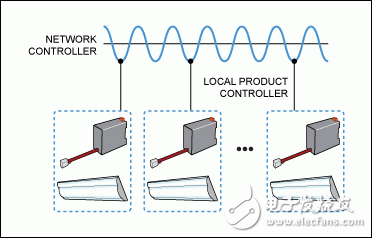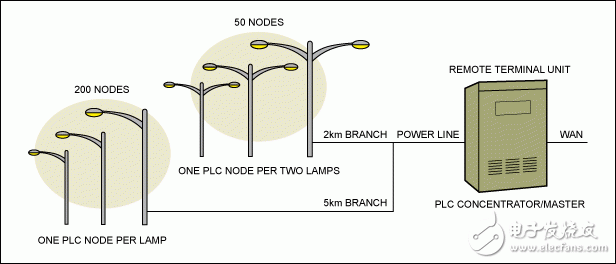introduction
There are various forms of street lighting—road lighting, tunnel lighting, parking lot lighting, and city lighting—the main power consumption systems. In fact, outdoor lighting is estimated to account for about 19% of global power consumption today. For municipalities and commercial establishments with large facilities, street lighting occupies a considerable portion of operating expenses. Street lamp lighting is also the key to public safety. Ensuring that street lamps are lit reliably and work at the optimal illumination suitable for passers-by and vehicle traffic is critical for both public safety and operators. It can be seen that any improvement in energy consumption, work reliability and maintenance costs will bring huge returns to the street lamp management department. Of course, the reduction in energy consumption will also produce significant environmental benefits.
Power line communication (PLC) is the best choice for automatic management of street lighting. PLC helps to reduce the operating expenses of enterprises and municipal departments and improve safety. G3-PLC is a new PLC system based on OFDM, designed for power grid automation equipment, which greatly expands the range, data rate and performance of power line communications. This article discusses the advantages of implementing system automation based on G3-PLC, and introduces a set of tunnel lighting solutions that can effectively reduce energy consumption and maintenance costs. This article introduces the basic principles of the system, gives key performance parameters and highlights the transceivers designed for PLC automation.
PLC system brings benefits to the environment and operators
G3-PLC provides a set of simple street lamp network communication solutions. Two-way communication supports higher requirements for automation design:
Determine the exact time to turn on / off the lighting system based on geographic location, calendar and weather conditions
Adjust the brightness of the light at dawn / dusk and late at night
Traffic control through dimming
Traffic monitoring
Street lamp failure alarm
Inform street lamp maintenance time based on temperature, current, PF or working hours
Emergency turn on / off / control lighting brightness
Monitor energy consumption in real time
Compared with wireless communication systems, PLC has many advantages. The PLC system also does not need to re-lay cables, and PLC communication can transmit data through the ground and walls. The channel is owned by the operator or the power company, and there is no risk of frequency band conflicts. PLC has no line-of-sight restrictions and is not affected by weather. In addition, because PLC uses power line communication, it is possible to detect line faults and their approximate location.
Tunnel lighting: PLC design case
PLC can reduce energy consumption and operating costs, and the effect is remarkable, we take a new PLC system as an example to illustrate. This technology is currently used by Nyx Hemera Technologies for tunnel lighting. Compared to fluorescent lighting systems, the tunnel lighting control system (TLACS) can save energy by 25% and reduce maintenance costs by 30%. Adjusting the lighting intensity to the same light intensity as the tunnel entrance and exit environment greatly improves safety.
The TLACS system is based on the OFDM PLC product provided by Maxim Integrated Products. Even if the signal level is lower than the noise, it can also receive a severely attenuated signal after being transmitted through a long-distance power line. The addressing capability and high data rate of the Maxim solution enable Nyx Hemera Technologies to support up to 1022 lamps with a single system. The TLACS system supports a transmission distance of 3km. Due to the use of power line transmission, you can choose a modular design, which is easy to install into the existing lighting system (Figure 1).

Figure 1. Schematic diagram of PLC scheme. In the TLACS system of Nyx Hemera Technologies, the local controller integrates PLC, communicates with the network controller through the AC line, and uses a standard DALI interface to control each street lamp.
Optimized automated lighting system
The performance and capacity of an automated lighting system are determined by the coverage, data rate, noise immunity, and routing capabilities of the PLC system.
A typical street lamp lighting topology is shown in the following figure (Figure 2). Concentrators connected via WAN (eg optical fiber, 2G / 3G wireless unit) communicate with the modem network or node that controls each lamp. The coverage of the PLC modem determines the number of nodes where the concentrator can communicate directly. The greater the number of nodes, the higher the efficiency of system implementation.
Power line communication range is affected by many factors: branch—shunt signal power; signal attenuation—changes with frequency; interference—such as noise introduced by switching power supplies, motors, and other users on the line. Due to the dynamic distribution of noise on the power line (that is, the noise source changes with time), noise immunity plays a decisive role in maintaining the basic performance of automated systems. By introducing a routing function in the node, a mesh network can be constructed, allowing nodes connected to the concentrator to extend / receive the message from the concentrator or even more distant nodes, and expand the communication capabilities of the network. Although the mesh network can greatly expand the coverage of a single concentrator, the power line communication rate determines the scale that the corresponding service can support. Since the street lighting network has only one channel from the network to the concentrator, all forwarded messages must be transmitted through one or more shared links, so that the link becomes the system bottleneck.

Figure 2. Typical topology of an automated street lighting network.
MAX2992 is a G3-PLC compatible transceiver. The device has leading performance, through advanced functions to achieve automatic management of street lighting, to meet the PLC system requirements for coverage, data rate, noise resistance and routing. The MAX2992 meets the requirements of the standard IEEE® P1901.2 for low-frequency PLC communication and is compatible with ITU G.9955 / G.9956 G3-PLC. The modulation uses DBPSK, DQPSK and D8PSK, and can support data rates up to 300kbps in the FCC band (10kHz to 487.5kHz). Even in a signal-to-noise ratio (SNR) of -1dB, the reliable mode can maintain normal communication. The transceiver uses dynamic link adaptation technology to automatically select the optimal modulation method and data rate based on channel conditions. In addition, adaptive frequency mapping avoids interference by selecting the sub-band with the least noise, thereby allowing higher-order modulation to automatically adjust to the highest data rate. When adding or reducing nodes, the automatic networking mechanism configures the mesh network. When transmitting messages, the dynamic routing mechanism identifies and updates the best routing path on the network.
The capacity and performance of the street lighting network is determined by the power line topology (including the number and location of transformers), the power line conditions, the selected frequency band, and the message frequency. When using DB8PSK modulation in the entire FCC band (10kHz to 487.5kHz), the data rate of the MAX2992 is as high as 300kbps. The FCC frequency band is widely used in many other countries such as the United States. When communicating via power line transformers or long distances, the SNR decreases due to signal attenuation. The MAX2992 automatically switches to DQPSK with a typical data rate of 150kbps.
The topology of the street lighting network affects the communication range and mesh network configuration. The branches on the power line shunt PLC signals, thereby shortening the communication distance and generating additional branches in the network. In addition, network management is the foundation of network performance. For the network where the concentrator polls the nodes, the message delay can be predicted; for the network that each node sends on demand, it is easily affected by network conflicts, resulting in delay fluctuations. Topology and line conditions have a significant impact on network performance, so it is difficult to estimate the capacity and performance of a particular network. Therefore, the network should be opened according to the data collected by the corresponding message frequency and network management system during the trial operation.
In street lighting applications, predictable message delay is usually preferred over variable message delay. In this case, it is recommended that the concentrator poll the nodes. When using the Round-Robin polling method, the more nodes there are in each concentrator, the longer the interval between messages sent to any node. Automated lighting management, such as controlling dimming or checking traffic flow, can compensate for predictable message delays for scheduled events.
Solution advantages
Through the following calculation, the largest network using G3-PLC technology can get the most benefit. G3-PLC is used in the FCC frequency band from 10kHz to 490kHz, and the point-to-point sending message takes 0.017s, during which about 180 bytes of data are transmitted. For a large network of 1,000 lamps, the average distance is 80m and the total length of the line is 80km.
Due to the attenuation of the PLC signal generated by the distance or the transformer, the concentrator cannot directly communicate with each node. In this case, the G3-PLC mesh architecture is used to make each node a repeater and forward the messages between the concentrator and each node. This example uses 7 transponders (Table 1) with an average forwarding delay time of 0.005s. A single concentrator is used. The concentrator polls all nodes. The total time for the concentrator to send a message to each lamp is 10 minutes. This time interval allows the operator to turn on the street lights or change the luminosity according to the position of each lamp (for example: on a hillside, in an underground passage or in a trough). Even if all street lights must be controlled, the maximum delay is only 10 minutes. If you need to send the same command to all street lights, such as the emergency "open" command, you can use the broadcast command to reach all street lights in less than 2s.

in conclusion
Street light manufacturers, automation system integrators and OEM communication equipment manufacturers are using PLC technology to deploy automated street light lighting systems to achieve power saving and reduce maintenance costs. The use of this technology can enable operators to obtain returns in the short term and improve surroundings. The MAX2992 PLC transceiver can automatically network, select the best routing path, and has the advantages of trans-transformer transmission and IPv6 support. These features greatly simplify the deployment of automated street lighting systems. Provide leading performance indicators, support large-scale network design, and provide higher security while saving energy consumption.
Stainless Steel Cold Rolled Sheet
Stainless Steel Cold Rolled Sheet,Stainless Steel Diamond Plate,Stainless Steel Metal Plate,Stainless Checkered Plate
ShenZhen Haofa Metal Precision Parts Technology Co., Ltd. , https://www.haofametal.com